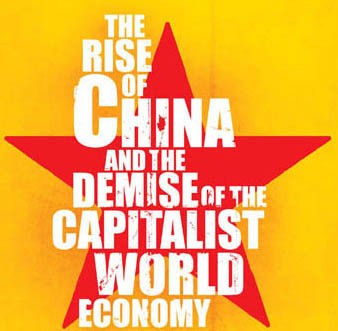China in the age of transition

A new Chinese revolution could turn the global balance of power again to the favor of the global working classes and progressive social forces.
According to the world historical statistics compiled by Angus Maddison, in 1820 China was the world’s largest national economy, accounting for 33 percent of the gross world economic product. Over the following one and a quarter century, China was incorporated into the capitalist world system and suffered massive and sustained declines. By 1950, China was reduced to a peripheral member of the capitalist world system with one of the lowest per-capita incomes.
The triumph of the Chinese Revolution in 1949 prepared the political conditions required for modern capital accumulation. From the 1950s to the 1970s, China made major advances in basic industrialization. By the late 20th century, China became the main beneficiary of the global capital relocation that took place in response to the global capitalist crisis in the 1970s. As China becomes the center of global manufacturing and production, a large and potentially militant working class is emerging and China is becoming the focus of global economic, social and ecological contradictions. How these contradictions are resolved will help to determine not only China’s but also the global future in this age of transition.
Transition from socialism to capitalism
From the early 19th century to the mid-20th century, successive Chinese ruling classes (from the Manchurian Qing dynasty to Chiang Kai-shek’s Nationalist regime) had failed to meet effectively the historical challenges imposed by China’s incorporation into the capitalist world system. With the rural economic surplus concentrated in the hands of the semi-feudal landlord class and the government tax revenues absorbed by war indemnities, military expenditures and corruption, few economic resources were left for capital accumulation and industrialization.
The Communist Revolution, by mobilizing the great majority of the population (peasants and workers), eliminated the entire old ruling classes and established the basic political conditions required for modern capital accumulation. To undertake capital accumulation, economic surplus had to be concentrated in the hands of the state. In return, the bargain-state provided the workers and peasants with the “iron rice bowl”—a basic package of social security—and promised to use the economic surplus for the interest of the people as whole. This socialist social contract required limitations on the elites’ material privileges.
To manage industrialization and economic growth, however, it was necessary for the socialist state to rely upon a small minority of technocrats with managerial and technical skills. Many of them came from the landlord and capitalist families. As industrialization progressed, both the technocrats and the Communist Party elites demanded growing material privileges. The conflicts between the new privileged bureaucratic-technocratic class and the workers and peasants threatened to undermine and destroy the post-revolutionary socialist social contract.
During the “Great Proletarian Cultural Revolution,” Mao Zedong made an unprecedented attempt to revive the Chinese Revolution by directly mobilizing the workers and students to rebel against the “capitalist roaders who are in authority in the Party.” The bureaucratic elites reacted with force and took advantage of the various divisions between different workers’ and students’ groups. By the early 1970s, as the Chinese and the global revolutionary upsurges receded, China found that it remained a part of the capitalist world system.
Socialist China had to be governed by the basic laws of motion of the capitalist world system. It had to compete against capitalist states economically and militarily. Despite China’s success in basic industrialization, it lagged behind the Western capitalist economies and the East Asian new industrializers in technology and labour productivity. Unlike the oil exporters, China did not have natural resources. A cheap and abundant labour force was the only significant “comparative advantage” that China could count on in the global market. But to exploit this comparative advantage, the socialist social contract had to first be dismantled.
In the 1980s, the Chinese urban working class was protected by the socialist social safety net and had considerable bargaining power. But after Mao’s death, workers were disillusioned with socialism and became politically disoriented. As China’s economic growth accelerated, demand for imported goods surged but the state-owned industries were unable to compete in the world market. By the second half of the 1980s, China experienced rising trade deficits and surging inflation. Milton Friedman visited China and advised Zhao Ziyang, the General Secretary of the Communist Party and the Prime Minister, to implement a full-scale shock therapy.
In the 1980s, the urban middle class (professional and technical workers) supported the capitalist transition enthusiastically. In addition to benefiting from capitalist transition materially (by having access to the transnational middle-class high-skill labour market), the urban middle class also hoped that the transition would allow them to share some of the political power. The various “democratic” activists mainly represented their class interests.
The various social conflicts culminated in the 1989 democratic movement. The liberal intellectuals and college students demanded “democracy.” In effect, they asked for sharing political power with the Communist Party in exchange for support of the capitalist transition. The democratic movement was defeated. The leading liberal intellectuals gave up the challenge to the Communist Party and settled for a junior position in the pro-capitalist political alliance.
By the 1990s, various capitalist industries had exceeded the state-owned industries in economic output and employment. The urban working class was isolated and disorganized. The ruling class was ready for the final offensive. Most state-owned enterprises were privatized and tens of millions of workers were laid off. Chinese capitalism was ready to take off.
Transition from capitalism to socialism?
In the first half of the 20th century, the capitalist world system suffered a massive structural crisis. To survive, the global capitalist elites had to make major concessions to the Western working classes and the non-Western national liberation movements. The unprecedented global economic expansion during the 1950s and 1960s depleted the remaining rural surplus labour force in North America and Western Europe, further strengthening the bargaining power of the Western working classes. By the 1970s, the Western capitalist economies suffered from declines of profit rates and persistent “stagflation” (combinations of high unemployment and high inflation).
To re-create conditions favourable for global capital accumulation, it was necessary for Western capitalism to restore the profit rate. It in turn required turning the balance of power between the workers and the capitalists to the favour of the capitalists. Monetarist macroeconomic policies (proposed by Milton Friedman) were implemented. In effect, these were economic schemes designed to break the backbone of labour unions by creating sustained high unemployment.
The monetarist macroeconomic policies were costly for the capitalists as well. High unemployment resulted in deep recessions that reduced capitalist profits in the short run. To turn the balance of class power decisively to the capitalist favour, it was necessary to expand and exploit the global reserve of cheap labour force. China’s capitalist transition played a crucial role in this regard. By supplying the global capitalist market with hundreds of millions of cheap, educated and disciplined workers, China emerged as the new global “workshop,” center of manufacturing exports.
The very success of China’s capitalist industrialization has created a large industrial working class. Until recently, China had been a capitalist paradise where capitalist exploitation met little resistance from workers and was reinforced by brutal police repression. Since 2007, however, waves of strikes have hit various capitalist sectors. A new generation of Chinese workers has developed a higher level of class consciousness and a growing capacity to organize.
The urban middle class used to be a strong social base for capitalist transition. But in recent years, many of them have struggled under surging housing prices, education costs and health care costs. New college graduates have to compete with migrant workers for jobs. The social and economic polarization destroyed the “middle-class dream” for many of the Chinese professional and technical workers. In this context, many young students have become politically radicalized and the Maoist left has expanded to become a significant political force.
The growth of Chinese capitalism has been based on the intense exploitation of a large and cheap labour force, exports to Western markets and depletion of natural resources and environmental space. Since the 2008–9 global economic crisis, the Western capitalist economies have struggled with persistent stagnation. In the future, China’s exports growth is likely to decelerate but China’s imports of foreign technologies and natural resources will continue to grow.
As Chinese exports slow down, the Chinese economy has become excessively dependent on investment. Almost half of China’s economic output now derives from investment. In a few years, China’s over-investment is likely to translate into falling profit rates and massive liabilities in the financial system. When China’s investment boom comes to an end, both the Chinese and the global economy may sink into another economic crisis.
On the other hand, China has become the world’s largest energy consumer and the largest carbon dioxide emitter. China has overtaken the US to become the world’s largest net oil importer. In recent years, US oil production has surged by exploiting environmentally destructive shale oil resources. But the shale oil boom may not last long. In fact, the US Energy Information Administration projects that US oil production will peak again in 2019 and decline thereafter (US Energy Information Administration, Annual Energy Outlook 2014 Early Release, released December 16, 2013). As US oil production passes the peak, the world oil production may start to decline and stagnate. In that case, the world will struggle to meet China’s rising oil demand.
By the 2020s, economic, social and ecological contradictions are likely to converge in China, leading to the demise of China’s existing social system. An anti-capitalist alliance may be formed between the urban working class, the rural semi-proletariat and the progressive sections of the urban middle class. A new Chinese revolution could turn the global balance of power again to the favor of the global working classes and progressive social forces.
Minqi Li taught political science at York University from 2003 to 2006. Since 2006, he has taught economics at University of Utah. His recent books include The Rise of China and the Demise of the Capitalist World Economy and Peak Oil, Climate Change, and the Limits to Economic Growth (Routledge, 2014).




